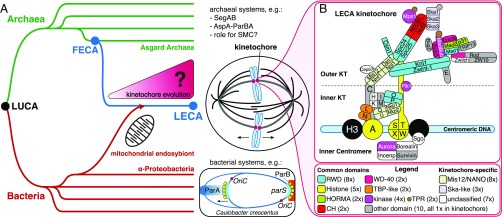Fig. 1.
The eukaryotic kinetochore and mitotic machinery originated between FECA and LECA. (A) How did the eukaryotic kinetochore originate and evolve between FECA and LECA? Eukaryotes (blue) are descended from Archaea (green) and likely are closely related to the Asgard archaeal superphylum (59). This Asgard-related lineage incorporated an Alphaproteobacterium via endosymbiosis; the latter gave rise to the eukaryotic mitochondrion. Archaea and Bacteria (red) do not separate their duplicated chromosome(s) via a mitotic spindle (11–13). For example, bacteria such as Caulobacter crescentus operate the parABS partitioning system, in which parS DNA sites are recognized by the protein ParB, stimulating ParA, which in turn pulls or pushes the chromosomes apart (12). Due to these differences, the mitotic spindle and the kinetochore probably originated between the FECA and the LECA. LUCA, the last universal common ancestor. (B) The kinetochore of LECA consisted of 52 proteins that contain domains found in other, nonkinetochore eukaryotic proteins as well (“common domains”) or that are unique to the kinetochore (“kinetochore-specific”). KT, kinetochore.

